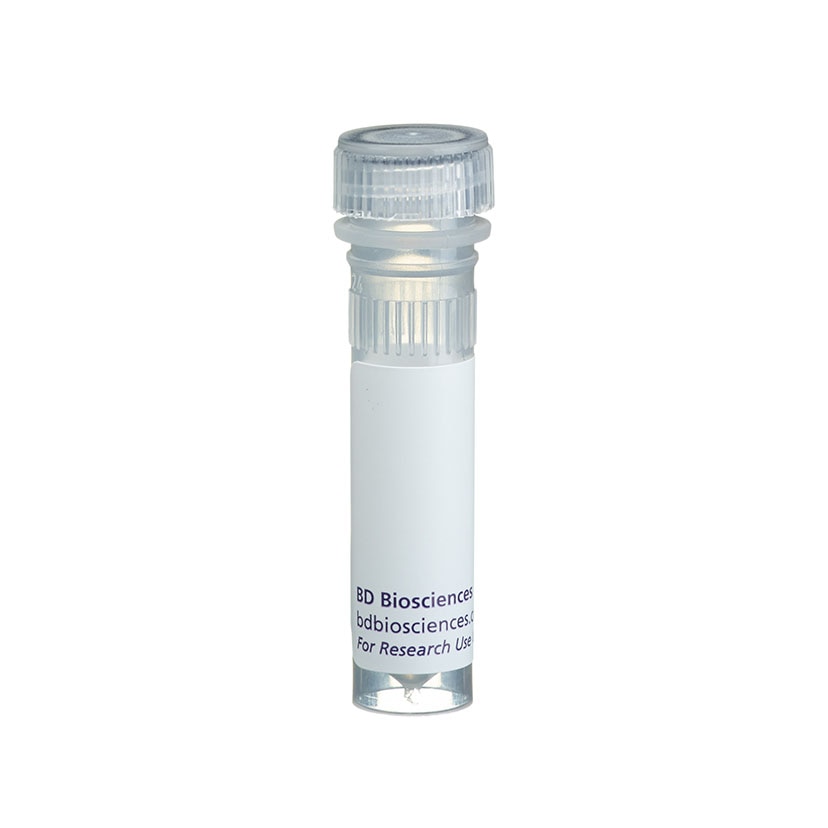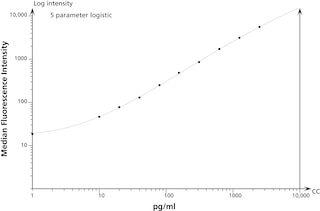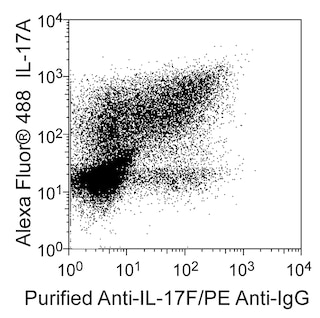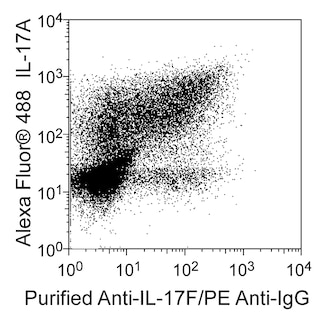Old Browser
This page has been recently translated and is available in French now.
Looks like you're visiting us from {countryName}.
Would you like to stay on the current country site or be switched to your country?
BD Pharmingen™ Purified NA/LE Mouse Anti-Mouse IL-17F
Clone MM17F8F5 (also known as MM17F8.F5; MM17F.8F5; MM17F-8F5)
(RUO)



Neutralization of mouse IL-17F biological activity with MM17F8F5, a Mouse Anti-Mouse IL-17F monoclonal antibody. In a 96-well microplate, biologically-active recombinant mouse IL-17F protein (0.2 μg/well) was preincubated (1 hr, 37°C) with serial dilutions of Purified NA/LE Mouse Anti-Mouse IL-17F antibody (Cat. No. 563592; μg/ml) or tissue culture medium (as a control). Following the incubation, cells from the NIH-3T3 mouse embryonic cell line were added at 5 x 10^4 cells per well and were cultured at 37°C. After 24 hours of culture, the supernatants from each well were harvested and their concentrations of IL-6 were quantified using a BD™ Cytometric Bead Array Mouse IL-6 Flex Set (Cat. No. 558301). As the MM17F8F5 antibody was serially diluted, a neutralizing Anti-Mouse IL-17F antibody dose-response relationship was observed as shown in the figure.


BD Pharmingen™ Purified NA/LE Mouse Anti-Mouse IL-17F

Regulatory Status Legend
Any use of products other than the permitted use without the express written authorization of Becton, Dickinson and Company is strictly prohibited.
Preparation And Storage
Product Notices
- Since applications vary, each investigator should titrate the reagent to obtain optimal results.
- An isotype control should be used at the same concentration as the antibody of interest.
- Sodium azide is a reversible inhibitor of oxidative metabolism; therefore, antibody preparations containing this preservative agent must not be used in cell cultures nor injected into animals. Sodium azide may be removed by washing stained cells or plate-bound antibody or dialyzing soluble antibody in sodium azide-free buffer. Since endotoxin may also affect the results of functional studies, we recommend the NA/LE (No Azide/Low Endotoxin) antibody format, if available, for in vitro and in vivo use.
- Alexa Fluor® is a registered trademark of Molecular Probes, Inc., Eugene, OR.
- CF™ is a trademark of Biotium, Inc.
- Cy is a trademark of GE Healthcare.
- Please refer to www.bdbiosciences.com/us/s/resources for technical protocols.
Companion Products






The MM17F8F5 monoclonal antibody specifically binds to Interleukin-17F (IL-17F) and can neutralize its biological activity. IL-17F is a member of the IL-17 family of cytokines. Among IL-17 family members, IL-17F has the highest amino acid sequence homology to IL-17A. IL-17F is produced by activated CD4+ T helper (Th17) cells, CD8+ T (Tc17) cells and γδ T cells. IL-17F can be secreted as homodimers or as heterodimers with IL-17A. IL-17F and IL-17A have overlapping functions such as inducing epithelial cells and fibroblasts to produce proinflammatory cytokines and chemokines including IL-6, GM-CSF, CXCL1, CCL2, and CCL7. These factors attract and activate neutrophils and other cell types that mediate protective responses against pathogenic microbes or pathologic allergic or autoimmune diseases. IL-17 gene knockout studies have shown that IL-17F and IL-17A have independent functions as well. IL-17F and IL-17A exert their biological function by binding to and signaling through IL-17 receptors comprised of the transmembrane receptor subunits, IL-17RA (CD217) and IL-17RC.
Development References (9)
-
Chang SH, Dong C. IL-17F: Regulation, signaling and function in inflammation. Cytokine. 2009; 46(1):7-11. (Biology). View Reference
-
Dong C. Th17 cells: Current understanding of their generation and regulation. Eur J Immunol. 2009; 39(3):640-644. (Biology). View Reference
-
Hamada H, Garcia-Hernandez MdlL, Reome JB, et al. Tc17, a unique subset of CD8 T cells that can protect against lethal influenza challenge. J Immunol. 2009; 182(6):3469-3481. (Biology). View Reference
-
Ishigame H, Kakuta S, Nagai T, et al. Differential roles of interleukin-17A and -17F in host defense against mucoepithelial bacterial infection and allergic responses. Immunity. 2009; 30(1):108-119. (Biology). View Reference
-
Martinez GJ, Zhang Z, Chung Y, et al. Smad3 differentially regulates the induction of regulatory and inflammatory T cell differentiation. J Biol Chem. 2009; 284(51):35283-35286. (Biology). View Reference
-
Oda N, Canelos PB, Essayan DM, Plunkett BA, Myers AC, Huang SK. Interleukin-17F induces pulmonary neutrophilia and amplifies antigen-induced allergic response. Am J Respir Crit Care Med. 2005; 171(1):12-13. (Biology). View Reference
-
Personal communication. Jacques Van Snick. MM17F8F5 neutralizing antibody. .
-
Sutton CE, Lalor SJ, Sweeney CM, Brereton CF, Lavelle EC, Mills KH. Interleukin-1 and IL-23 induce innate IL-17 production from gammadelta T cells, amplifying Th17 responses and autoimmunity. Immunity. 2009; 31(2):331-341. (Biology). View Reference
-
Yang XO, Chang SH, Park H, et al. Regulation of inflammatory responses by IL-17F. J Exp Med. 2008; 205(5):1063-1075. (Biology). View Reference
Please refer to Support Documents for Quality Certificates
Global - Refer to manufacturer's instructions for use and related User Manuals and Technical data sheets before using this products as described
Comparisons, where applicable, are made against older BD Technology, manual methods or are general performance claims. Comparisons are not made against non-BD technologies, unless otherwise noted.
For Research Use Only. Not for use in diagnostic or therapeutic procedures.
Report a Site Issue
This form is intended to help us improve our website experience. For other support, please visit our Contact Us page.